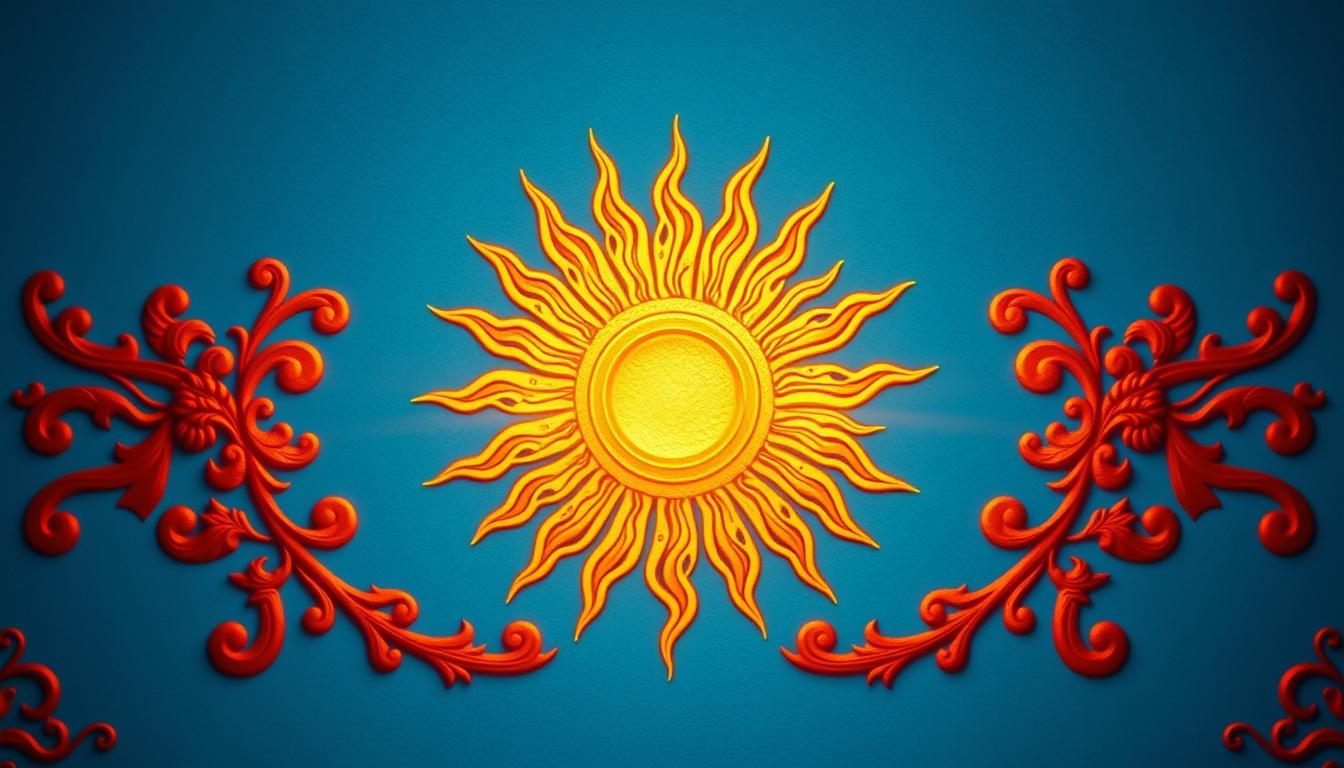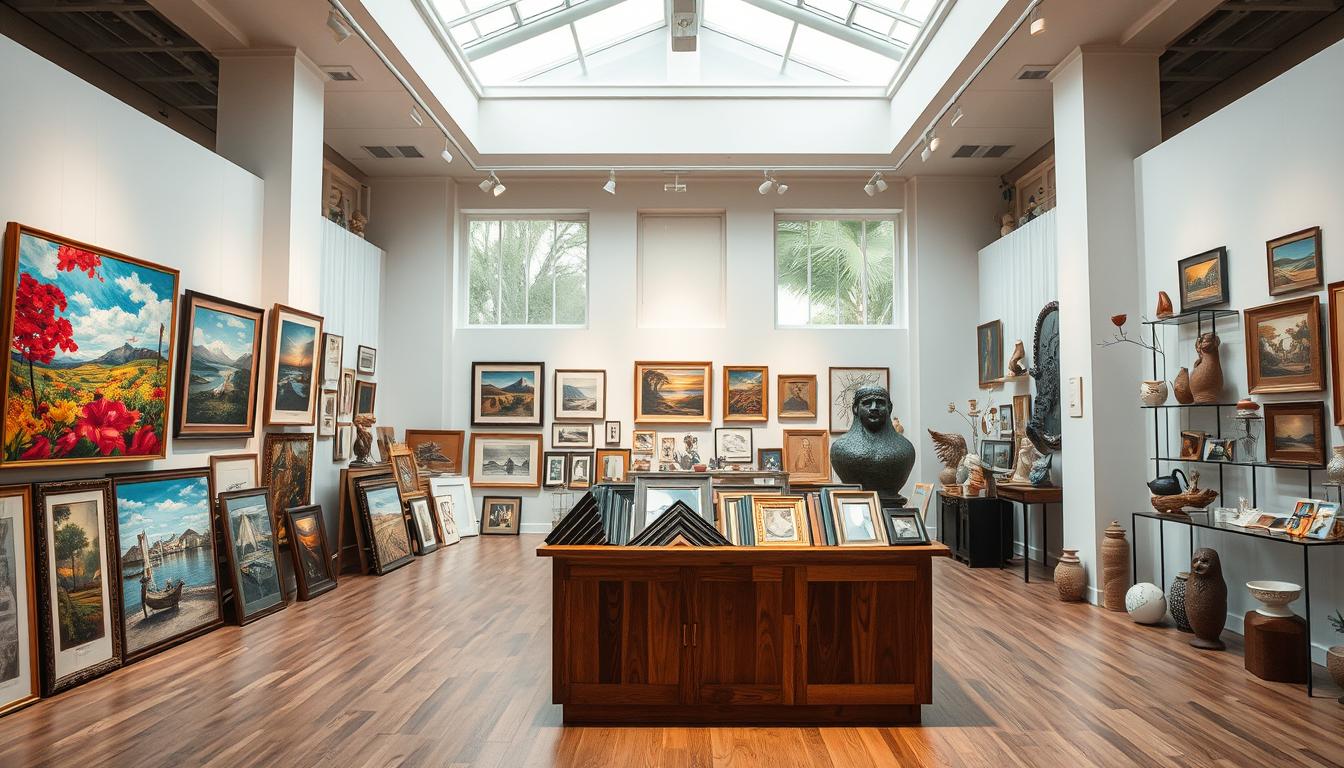Can one golden image change how we see life and time?
The sun has inspired painters, poets and sculptors across the world for centuries. Museums like the Smithsonian show how this star appears as both literal light and a deep, shared symbol.
Artists return to the sun to speak about creation, growth and guidance. It marks the rhythm of the day and helps measure time, while giving scenes warmth and direction.
The motif appears in European Christian pieces such as sunburst monstrances and in Andean art honoring Inti. These examples link personal moments—like a beam through a window—to broad cultural stories that tie humans together.
In this short tour, expect clear examples, museum references and friendly explanations that show why the sun endures as a center of meaning. For an anchored guide to these traditions, see this brief overview at sun symbolism and objects.

Key Takeaways
- The sun is a powerful symbol of life, light and renewal across cultures.
- Artists use it to connect personal moments with big themes like creation and authority.
- Motifs such as rays, halos and pathways of light help tell stories about time and the sky.
- Interpretations shift as cultures gain new knowledge and artists try new techniques.
- Museum collections preserve diverse examples, from Andean Inti imagery to European sunbursts.
The sun in art today: life, light, and power
Contemporary makers often use the sun to show the steady energy that fuels plants, cities, and daily routines. Museums and collections still record how light shapes mood and seasonality; the Smithsonian’s sunburst logo speaks to enlightenment and shared knowledge.
Life and warmth: the sun as a source of growth and vitality
Life appears through warm palettes, gold-leaf highlights, and textured surfaces that mimic heat on leaves and skin. Artists choose materials—metallic foil, resins, woven fibers—to capture the sensation of warmth and sustained energy.
Light and beauty: illuminating forms, colors, and stories in the sky
Light makes edges crisp and brings out color contrasts, guiding viewers through visual stories. Stylized rays and layered glazes give paintings and installations extra presence, suggesting both daily cycles and quiet power.
- Artists use glow to emphasize mood and narrative.
- Warm fields and halos hint at vitality and social meaning.
- See how contemporary makers translate solar energy in materials like mosaics and gold accents by exploring mosaic sun wall art.
What does a sun symbolize in art?
Across cultures, artists place the sun at the visual center to signal origin, warmth, and order.
Creation and renewal: Many works treat the sun as the origin and sustainer of life. Andean depictions of Inti show the solar being as a living force that feeds crops and communities. Museums such as The Met preserve Anatolian and Calima examples that link daily survival with cosmic care.
Authority and divinity: Gold surfaces and sunburst designs convey power and holiness. European Christian monstrances use radiant gold rays to frame the consecrated host, turning the object into a shining center of sacred presence.
Time and rhythm: Artists chart the day through arcs, shadows, and shifting color. Sunrise-to-sunset sequences map labor, rest, and ritual, helping viewers sense the passage of time and the steady cycle that governs life.
- Rays and halos turn light into concrete forms of spiritual force.
- The sun functions as both natural heat and moral clarity.
- Museum holdings confirm ongoing meanings across regions and ages.
Sun and moon: polarity, eclipse, and balance in symbols
Artists pair day and night to show how opposite energies shape life and mood.
Polarity of energies: Design traditions often link the sun to firmness, strength, and visible force. The moon answers with calm, beauty, and gentle care.
Polarity of energies: firmness and strength versus calm and nurturing
Compositions place bold rays beside soft crescents to make duality clear. Paired motifs give viewers an easy read: one side asserts, the other soothes.
Eclipse as fleeting wonder: capturing the moment when day turns to night
An eclipse becomes a dramatic subject. Artists use it to mark sudden balance between light and shadow and to suggest brief change.

Finding our way: sundials, stars, and the sky as a guide
People historically navigated by sun, moon, and stars. Sundials acted as early clocks and inspired visual signs for time and direction.
| Element | Typical Meaning | Artistic Use |
|---|---|---|
| Sun | Strength, clarity, action | Sharp rays, gold, centered placement |
| Moon | Calm, nurture, reflection | Soft glow, silver tones, offset halos |
| Eclipse | Transient balance, awe | High contrast, silhouetted forms |
| Stars / Sundial | Navigation, order | Compass motifs, hour markers |
Placing both bodies together signals cycles—waxing and waning, rising and setting—and invites viewers toward the center where opposites meet.
Across cultures and collections: from Inti to European monstrances
Traveling icons of the sky show how one motif can hold power, blessing, and memory across places.
Andean traditions center on Inti, the Incan solar deity. In South and Central America, rulers used solar images to claim lineage and care for the land. These motifs appear in textiles, metalwork, and ritual objects that link daily life to divine authority.

Andean sun gods and South American traditions: Inti and enduring symbols
Inti functions as both life source and political emblem. Museums hold ceramics and tunics that show concentric circles and rays at the center of community identity.
Christian and European art: the sunburst monstrance and sacred light
European monstrances use radiant spokes and gold surfaces to frame the Eucharist. Institutions like The Met, Museo de America, and Museo Pedro de Osma preserve examples that show how sacred light became a public sign of blessing.
Ancient and global views: Anatolian, Calima, and Mediterranean sun motifs
Ancient Anatolian and Calima designs reveal trade and exchange across the world. Simple circles and radiating lines travel between regions, keeping a visual center while gaining local stories and meaning.
- Collections document hybrid images where Indigenous and Christian signs meet.
- Gold and procession link value to eternal light and social authority.
- These objects remain a rich source for studying shared belief across cultures.
Artists, materials, and ways of seeing the sky
Through textiles, paint, and metal, people shape celestial ideas into everyday forms. This section shows how makers translate close observation and cultural memory into objects that teach and move.
A quilted solar system: teaching with textiles and celestial diagrams
Ellen Harding Baker’s Solar System quilt (1876) stitched wool into a working diagram. She used telescope sketches and lectures to share stars, planets, and the sun with local audiences.
Painting an eclipse: abstract color blocks and shifting light
Alma Thomas’s The Eclipse (1970) uses bold color fields and an asymmetrical view to capture fleeting mood. Her Space Paintings followed the Moon landing and brought cosmic wonder to galleries.
Midnight sun in jewelry: Inuit perspectives in silver and gold
Jonasie Faber’s Midnight sun (2005) turns Arctic experience into wearable form. Silver and gold reflect months of continuous light and ground sky stories in personal objects.
Enlightenment and logos: the sunburst as a symbol of knowledge
The Smithsonian’s sunburst logo keeps the sun also as a public source of learning. Institutions and artists together frame curiosity as shared light.
| Work | Medium | Key feature |
|---|---|---|
| Solar System quilt | Wool textile | Educational diagram, telescope-based |
| The Eclipse | Acrylic painting | Abstract light, rhythmic color |
| Midnight sun | Silver & gold pendant | Place-based reflection, wearable |
Conclusion
Light and ritual keep returning to the sky as makers map human cycles onto canvas, cloth, and metal. The sun stands as an enduring symbol of life, warmth, and light that crosses places and ages.
Artists and museums—like the Smithsonian—still use solar imagery to tell stories about the day, time, and our shared journey from shadow into clarity. Notice small things: shadows, glints, and rays. They spark fresh ideas and become paintings, textiles, or jewelry.
Pairings of sun and moon shape balance in works, guiding viewers through cycles of rest and action. Global collections preserve these icons for the world and invite ongoing curiosity.
Keep looking up. Let stars by night and the bright sky by day feed your view of beauty and the long story that artist and human hands keep making. For more on related themes, see sun and moon motifs.
Enhance Your Space with Unique Modern Masterpieces
Are you inspired by the innovative mediums and conceptual depth highlighted in our exploration of contemporary art? You’re not alone! Today’s art enthusiasts are seeking cultural relevance and emotional connections in their artwork. However, finding pieces that resonate with modern themes and fit your unique style can be a challenge. That’s where we come in!
At Rossetti Art, we specialize in canvas prints, original paintings, and modern sculptures that celebrate the spirit of now. Each piece created by Chiara Rossetti brings a personal touch that connects deeply with current social narratives—just like the modern masterpieces discussed in the article. Don’t miss out on the chance to elevate your home decor with breathtaking artwork that speaks to your values and aesthetic. Explore our collection today and find your perfect piece! Act now, and transform your space into a gallery of inspiration!
FAQ
What meanings does the sun carry in visual culture?
The sun often stands for life, energy, and growth. Artists use its warmth to imply vitality and fertility. It can also signal clarity and revelation when placed to illuminate faces or landscapes. Across media, golden tones and radiating lines strengthen these associations.
How is light portrayed to enhance beauty and narrative?
Light sculpts form and mood. Painters like J.M.W. Turner and Gustav Klimt used sunlit color to create atmosphere and drama. In photography and film, backlighting and flares highlight textures and guide the viewer’s eye, turning ordinary scenes into striking stories.
In what ways does the sun represent creation and renewal?
Many works position the sun as origin and sustainer: it marks planting seasons, daily rebirth, and cycles of time. This makes it a natural emblem for beginnings, healing, and the repetition of life’s rhythms in both ritual art and popular imagery.
How do artists use sun symbolism to suggest authority or divinity?
Radiant motifs—halos, sunbursts, and gold leaf—signal power and sacred presence. Medieval and Baroque painters employed gold to link figures with heaven. Decorative objects like monstrances amplify light to convey holiness and elevated status.
What role does the sun play in expressing time and rhythm?
The sun marks hours and seasons. Sundials, shadows, and sun paths appear in art to track change and emphasize temporality. These devices help viewers read cycles and connect human life to celestial order.
How do artists show balance between sun and moon motifs?
Pairing sun and moon highlights complementary forces: action versus reflection, heat versus coolness. Composers of images use contrasts in color, texture, and placement to explore harmony, tension, or transformation—especially during eclipses.
What makes an eclipse a powerful subject for artists?
Eclipses compress wonder and transition into a brief event. Artists capture that fleeting interplay of light and dark to explore mystery, fear, and awe. The visual drama often becomes a metaphor for social or personal change.
How have different cultures depicted solar deities and symbols?
Cultures worldwide honored the sun: the Inca revered Inti, while Anatolian and Mediterranean crafts featured radiating discs. Each tradition adapted solar imagery to local materials, rituals, and cosmologies, producing diverse but related motifs.
Where does the sunburst appear in European sacred art?
In Christian art, the sunburst appears in monstrances, reliquaries, and altarpieces to represent divine light. Gold leaf and metalwork create luminous surfaces that draw attention and evoke spiritual presence during worship.
What materials do artists use to represent solar themes today?
Painters use gold leaf, warm pigments, and reflective varnishes. Jewelers favor silver and gold for sun motifs. Textile artists incorporate metallic threads and dyed circles. Contemporary creators also employ LED light, projection, and mixed media to simulate solar effects.
How can solar imagery teach about the sky and seasons?
Educational quilts, planetarium diagrams, and public murals use sun motifs to map seasons, solstices, and celestial navigation. These visual tools make abstract astronomy tangible and help communities connect with cycles of time.
Why is the sunburst a common logo and emblem for knowledge?
The sunburst suggests enlightenment—clarity, insight, and the dispersal of darkness. Universities, museums, and civic groups adopt the motif to signal learning, progress, and the public value of ideas.






Leave a comment
This site is protected by hCaptcha and the hCaptcha Privacy Policy and Terms of Service apply.